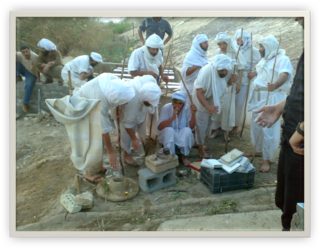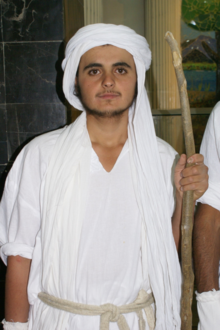
The Qulasta, also spelled Qolastā in older sources, is a compilation of Mandaean prayers. The Mandaic word qolastā means "collection".

A rasta is a white ceremonial garment that Mandaeans wear during most baptismal rites, religious ceremonies, and during periods of uncleanliness. It signifies the purity of the World of Light. The rasta is worn equally by the laypersons and the priests. If a Mandaean dies in clothes other than a rasta, it is believed that they will not reenter the World of Light, unless the rite "Ahaba ḏ-Mania" can be performed "for those who have died not wearing the ritual garment."
An uthra or ʿutra is a "divine messenger of the light" in Mandaeism. Charles G. Häberl and James F. McGrath translate it as "excellency". Jorunn Jacobsen Buckley defines them as "Lightworld beings, called 'utras ." Aldihisi (2008) compares them to the yazata of Zoroastrianism. According to E. S. Drower, "an 'uthra is an ethereal being, a spirit of light and Life."

Maṣbuta is the ritual of immersion in water in the Mandaean religion.
A ganzibra is a high priest in Mandaeism. Tarmidas, or junior priests, rank below the ganzibras.
In Mandaeism, laufa or laupa is the concept of a spiritual connection forged between Tibil (Earth) and the World of Light. It has been variously translated as "communion," "spiritual union," "spiritual connection," or "vital connection."
In Mandaeism, the pihta is a type of sacramental bread used with rituals performed by Mandaean priests. It is a small, round, biscuit-sized flatbread that can either be salted or saltless, depending on whether the ritual use of the pihta is for living or dead people.
The Šarḥ ḏ-Zihrun Raza Kasia is a Mandaean religious text that describes rituals such as the masbuta, masiqta, and other related topics. It is an illustrated scroll.

The drabsha or darfash is the symbol of the Mandaean faith. It is typically translated as 'banner'.

In Mandaeism, the klila is a small myrtle wreath or ring used during Mandaean religious rituals. The klila is a female symbol that complements the taga, a white crown which always takes on masculine symbolism.

In Mandaeism, the taga is a white crown traditionally made of silk that is used during Mandaean religious rituals. The taga is a white crown which always takes on masculine symbolism, while the klila is a feminine symbol that complements the taga.
In Mandaeism, Bihram or Bihram Rabba is an uthra who presides over the masbuta, or baptism ritual. Bihram is mentioned in Mandaean texts such as the Qulasta. Many Mandaean masbuta ritual prayers invoke the name of Bihram.
Daily prayer in Mandaeism, called brakha ࡁࡓࡀࡊࡀ in Mandaic or occasionally birukta (birukhta), consists of set prayers that are recited three times per day. Mandaeans stand facing north while reciting daily prayers. Unlike in Islam and Coptic Orthodox Christianity, prostration is not practiced.
In Mandaeism, a ʿniana or eniana prayer is recited during rituals such as the masiqta and priest initiation ceremonies. They form part of the Qulasta. The rahma prayers are often considered to be a subset of the eniana prayers.

The qabin is the Mandaean wedding ritual. Mandaean weddings are typically held for several days. Traditionally, weddings must be officiated by a Mandaean priest and can only be performed for ethnic Mandaeans, although this has proved to be challenging for the contemporary Mandaean diaspora.

In Mandaeism, riha is incense used for religious rituals. It is offered by Mandaean priests on a ritual clay tray called kinta in order to establish laufa (communion) between humans in Tibil (Earth) and uthras in the World of Light during rituals such as the masbuta (baptism) and masiqta, as well as during priest initiation ceremonies. Various prayers in the Qulasta are recited when incense is offered. Incense must be offered during specific stages of the typically lengthy and complex rituals.
Mandaean names can include both birth names and baptismal names, called malwasha (ࡌࡀࡋࡅࡀࡔࡀ) in Mandaic.
In Mandaeism, misha is anointing sesame oil used during rituals such as the masbuta (baptism) and masiqta, both of which are performed by Mandaean priests.
The Sidra ḏ-Nišmata, also known as the Book of Souls or Book of Gadana, is a collection of Mandaean litugical prayers that constitutes the first part of the Qulasta. It most likely constitutes the oldest stratum of Mandaean literature and dates to at least the 3rd century CE or earlier.









